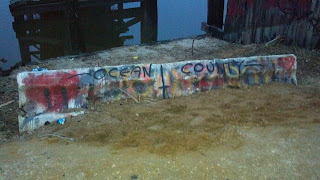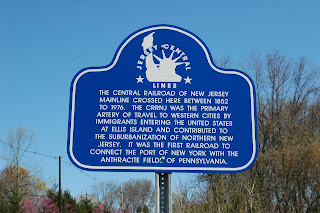If you grew up in Northern or Central New Jersey, there's a good chance you visited Morristown National Historical Park on a class trip. The place has a lot to capture a youngster's imagination, even aside from the obvious importance to our country's earliest days. I can recall stopping at the Wick family house to hear the legend of how the young girl Tempe hid her horse inside her family's tiny house to prevent soldiers from confiscating it. And, of course, there are a handful of huts at the edge of a clearing and atop a hill, facsimiles of the rows of rough housing soldiers built to shelter themselves from one of the harshest winters on record.
 The thing we didn't notice (or weren't made aware of) on those youthful trips was the cemetery which holds the remains of over a hundred Continental soldiers who perished during those bitter months. It's easy to overlook the burial grounds, even though they're bordered by Cemetery Road. Graves aren't marked with those familiar white U.S. military stones. In fact, they're not marked at all. The only indication that people are buried there is a weathered brass plaque on a large stone, placed there by the people of Morristown on Memorial Day, 1932. That would have been about 10 months before the property became America's first National Historical Park.
The thing we didn't notice (or weren't made aware of) on those youthful trips was the cemetery which holds the remains of over a hundred Continental soldiers who perished during those bitter months. It's easy to overlook the burial grounds, even though they're bordered by Cemetery Road. Graves aren't marked with those familiar white U.S. military stones. In fact, they're not marked at all. The only indication that people are buried there is a weathered brass plaque on a large stone, placed there by the people of Morristown on Memorial Day, 1932. That would have been about 10 months before the property became America's first National Historical Park.While soldiers didn't have to worry about dying in battle at Morristown, they faced an equally perilous threat from disease and deprivation. The exact causes of death for the roughly 100 in the cemetery aren't clear, but it's a pretty good bet that many fell victim to the lack of supplies -- food and clothing alike -- that plagued the encampments, especially the second one. General Washington had also ordered all troops to be inoculated for smallpox during the first encampment, which no doubt led to some deaths as well.
The first national military cemeteries were created after the Civil War, so those who died at Morristown were not afforded the same honors we're familiar with today. In many cases, soldiers were buried where they fell, or, as at Jockey Hollow, were placed in mass graves. Considering the hardships they endured and the uncertainties under which they served, it seems their final resting place deserves a more prominent marker and additional attention from those who visit the park. The people of Morristown seem to have understood this when they placed the marker over 80 years ago. Their words say it all:
More than one hundred Continental soldiers who made the supreme sacrifice for American Liberty are buried in this cemetery. Their comrades were housed in huts along the Jockey Hollow Road.
The people of Morristown reverently erect this monument as a tribute to them and to the valor of the Continental Army whose occupancy of Jockey Hollow has hallowed this ground.
The next time you're at Jockey Hollow, stop by and pay your respects. And if you're there on a particularly cold or especially snowy day, consider how long you'd be able to endure the conditions they did, barely clothed and fighting hunger. For so many reasons, they truly deserve our thanks and admiration.














